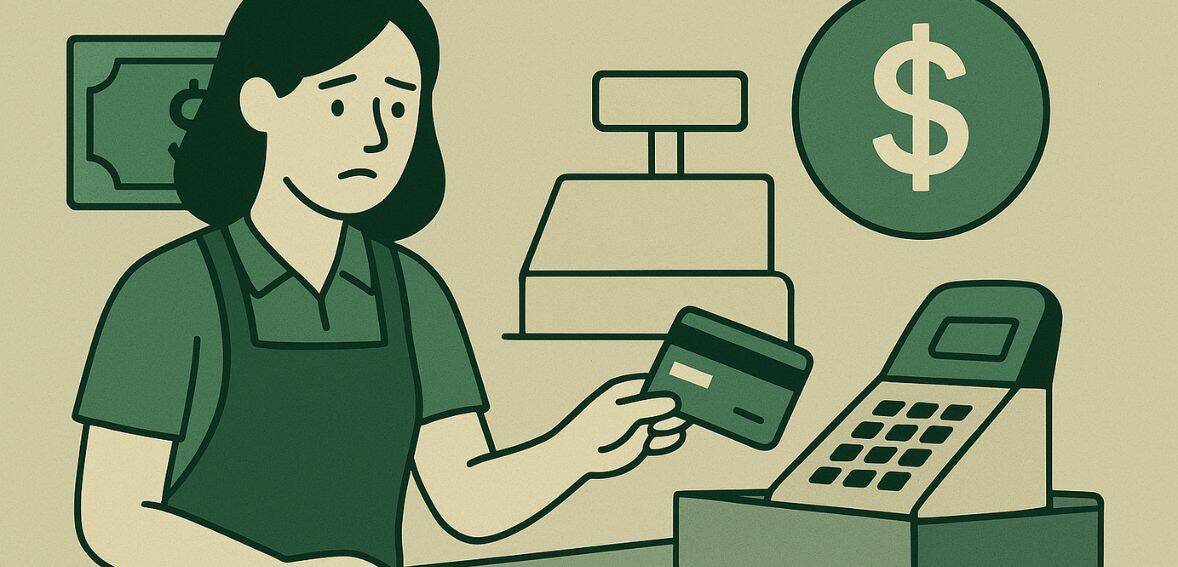
By alphacardprocess September 6, 2025
Every dollar matters to small businesses. Customers may find credit card payments convenient, but over time, the associated processing fees can subtly reduce profits. These expenses seem inevitable to many business owners—a cost incurred merely to meet customer expectations.
However, those few percentage points can mean the difference between breaking even and succeeding in a sector where margins are frequently extremely thin. The problem is exacerbated when companies don’t want to raise prices at the register for fear of upsetting customers.
Customers want fairness and transparency, and price increases linked to unstated expenses can strain already solid relationships. Fortunately, there are strategies to control processing fees without having to pay the burden directly to customers.
Understanding the Real Impact of Credit Card Processing Fees

At first glance, credit card fees usually seem minimal—perhaps two or three percent per transaction. However, the sum can be startling when multiplied by hundreds or thousands of transactions over the course of a month. For example, without realizing how much it reduces overall profit, a café that receives $40,000 in card payments each month could easily lose $1,200 or more in fees.
Processing fees vary based on the volume of payments, in contrast to fixed overhead costs like rent or utilities. This adds to the owners’ stress by making them less predictable and more difficult to budget for. Even worse, a lot of statements are purposefully unclear, with numerous line items that hide the true amount being paid. Businesses can start to recognize opportunities for minimal change if they have a thorough understanding of how these fees build up.
Why Raising Prices Feels Like a Trap
Raising prices universally is a natural response to growing processing costs. After all, why not pass the cost on to customers if fees are reducing revenue? However, in reality, this strategy may cause more issues than it fixes. With just a few clicks, consumers can compare prices across businesses, demonstrating their growing price sensitivity.
Loyal customers may choose to patronize competitors if menu items or services are slightly increased. The last thing a company can afford in highly competitive industries like food service, retail, or salons is to be perceived as “too expensive.”
Furthermore, consumers who pay with cash frequently feel that price increases linked to credit card fees are unfair. The challenge, then, is finding alternatives that preserve customer loyalty while protecting margins.
Negotiating With Your Processor
Negotiation is one of the most overlooked methods for reducing credit card fees. Although processors frequently have flexibility, many small business owners believe the prices they are quoted are final. Businesses can obtain leverage to demand better terms by closely examining statements and spotting inflated charges.
For example, it is frequently possible to negotiate lower or remove non-qualified transaction rates or excessive monthly account fees imposed by a provider. Knowing what other people are paying and being aware of industry averages are crucial. Additionally, switching providers can increase competition, which encourages processors to match or surpass more competitive rates.
Companies that periodically review these contracts instead of just renewing them typically save the most money. With time, even fractional reductions in rates can translate into thousands of dollars in preserved revenue.
The Role of Payment Technology

New methods for businesses to reduce expenses without affecting customers have been made possible by advancements in payment technology. For example, modern point-of-sale (POS) systems are better able to route transactions in a way that minimizes interchange fees.
Certain platforms can determine whether a transaction is eligible for reduced rates according to the type of card or the method of entry, guaranteeing savings at the point of sale. Secure card storage techniques and tokenization also lessen the possibility of chargebacks, which have additional processing fees on top of the original fee.
Businesses may discover that the initial investment in modernized systems quickly pays for itself in lower monthly costs. In addition, by expediting checkout and fostering smooth interactions that foster loyalty and reduce expenses, these technologies frequently enhance the customer experience.
Educating Customers Without Penalizing Them
Transparency is now a crucial component of modern corporate operations. Consumers are curious about why they are paying as well as what they are getting. While outright price increases can backfire, informing customers about costs can help them understand and even become loyal.
For example, because debit cards frequently have lower processing fees, many businesses now subtly encourage the use of these cards for smaller transactions. Others quietly advertise cash discounts or loyalty programs, portraying them as benefits rather than drawbacks.
Communicating the value to customers without making them feel obligated or guilty about using credit is crucial. With careful handling, these discussions have the power to turn clients into partners who understand the inner workings of a business.
Hidden Fees That Hurt the Most
Many processors include hidden fees—such as statement charges, gateway costs, or batch settlement fees—that might seem minor individually but collectively erode margins. Unreliable merchant partners with hidden costs in merchant services provider practices can add friction at checkout, silently costing sales and eroding customer trust.
These could be gateway access fees, PCI compliance fees, statement fees, or even batch settlement expenses. They might not seem like much on their own, but when combined, they can be very costly. For example, a $20 monthly compliance fee adds up to $240 a year, which could be used for equipment or marketing.
Businesses frequently only become aware of these hidden fees after carefully reviewing their financial statements, which can be daunting due to the complicated terminology. But if you don’t, you’ll be leaving money on the table every month. Although it takes time to identify and remove these fees, doing so frequently results in some of the cost savings that happen the fastest.
Cash Discount Programs Done Right

As a compromise between raising prices and paying fees, cash discounting has grown in popularity. The idea is simple: customers who pay with cash receive a small discount, but the listed price is based on card payments.
Execution is crucial. This tactic feels more like a reward than a punishment when used carefully. Businesses benefit from lower processing costs on transactions that switch to cash, and customers appreciate saving a little money. Since deceptive pricing can backfire, adherence to state and federal regulations is essential.
Cash discount programs can, however, achieve the ideal balance between cost containment and customer satisfaction if they are explained understandably and equitably. They offer flexibility without giving the impression that the company is unfair or opportunistic.
Building Stronger Vendor Relationships
Sometimes, overall vendor relationships are just as important as processors when it comes to cutting credit card costs. Better terms can be obtained by aligning with the preferred partnerships that vendors frequently have with particular processors.
For instance, a wholesale supplier may bargain for bulk processing rates that are then made available to its clientele. Businesses can access savings that they might not have been able to obtain on their own by utilizing these relationships.
Additionally, compared to dealing with big, impersonal providers, working with local banks or credit unions frequently results in better support and transparency. More favorable terms and a greater willingness to meet the particular needs of small businesses can result from building trust and communication with these financial partners.
The Importance of Ongoing Review
Treating credit card processing as a “set it and forget it” part of operations is one of the most frequent errors made by companies. Fee structures are regularly updated by providers, and if statements are not routinely reviewed, chances to spot errors or increases are lost. Rates are kept competitive and, needless charges are promptly identified with a quarterly or semi-annual review.
Sometimes, all it takes to get an unexpected fee removed is to call the provider. Payment processing should receive the same level of consideration as companies review their marketing plans, staffing levels, and budgets. Frequent monitoring guarantees that savings are consistently maximized over time and avoids surprises.
The Bigger Picture: Protecting Margins Without Sacrificing Service
In the end, reducing processing fees is intended to safeguard the company’s overall health rather than just reduce expenses. Every dollar saved on processing can be used for equipment, customer experience, staff training, or expansion. The alternative, which is to pass the cost directly on to customers, runs the risk of destroying the very connections that keep the company alive.
Businesses can achieve a balance between profitability and trust by implementing more intelligent tactics, such as technology, customer education, and negotiation. Cutting costs without increasing prices requires awareness, planning, and a dedication to long-term sustainability rather than cutting corners.
Employee Training as a Cost-Saving Tool

Improved staff training is one of the most overlooked strategies to indirectly lower processing fees. Errors can result in increased interchange costs because cashiers and employees frequently influence how transactions are entered. For example, the business pays a higher rate if a debit card transaction is inadvertently processed as “credit.”
Reducing needless expenses can be achieved by educating employees on best practices, such as promoting PIN debit entry whenever feasible. Employee awareness enhances consistency beyond mechanics. Employees stop being passive participants in cost control when they realize that handling payments accurately affects the bottom line.
Watching Out for Tiered Pricing Pitfalls
Because they seem simple—qualified, mid-qualified, and non-qualified rates—many companies are drawn to tiered pricing models. These arrangements, however, frequently conceal markups that reduce profits. Depending on the card type or processing method, a transaction that appears to belong in the “qualified” category may be swiftly moved up to a higher tier.
Retailers, eateries, and florists frequently unknowingly fall into this trap. Merchants can determine whether tiered pricing is inflating their fees by comparing processor statements with actual interchange costs. Most people find that switching to interchange-plus pricing increases transparency and stops the kind of hidden margin erosion that is caused by tiered pricing schemes.
Technology Upgrades That Pay for Themselves

Sometimes upgrading outdated equipment—rather than negotiating with a processor—is the fastest way to lower processing fees. Transactions may be forced into higher-risk categories by terminals that do not accept contactless or EMV payments, which could result in additional fees. Purchasing a cutting-edge POS system with advanced fraud detection guarantees that every transaction is eligible for the lowest interchange rate while also assisting in the reduction of chargebacks.
Even though upgrading hardware comes with an upfront cost, the money saved by avoiding fees and disputes usually makes up for the difference. Additionally, integrated analytics are frequently included in modern systems, providing businesses with greater insight into payment-related expenses and transaction trends.
The Hidden Cost of Chargebacks
Chargebacks can be an even greater financial burden than the percentages and transaction fees associated with credit card processing. In addition to losing the sale each time a customer contests a charge, the merchant must also pay additional chargeback fees, which can range from $25 to $100 per instance.
Furthermore, an excessive number of disputes may put the company in a high-risk category, raising processing rates in the future. Lower expenses are a direct result of reducing chargebacks through better communication, clear receipts, and delivery tracking. Businesses can avoid chargebacks, increasing the total cost of accepting credit cards, by proactively resolving disputes.
Building Loyalty Around Alternative Payments
Reducing credit card fees is crucial, but companies can also save money by gently encouraging clients to choose less expensive options. Processing fees for options like ACH, eChecks, and direct bank transfers are substantially lower. Businesses can shift a portion of transactions away from expensive credit card rails by rewarding customers who use these payment methods, possibly with small loyalty points or subtle discounts.
This creates balance but does not replace card payments. Even a 10–15% shift toward alternatives over time can result in significant cost savings, particularly for companies that deal with a lot of repeat business. It’s a cost-effective method that benefits customers without ever raising prices at the register.
Conclusion
Although they are sometimes viewed as a necessary evil, credit card processing fees don’t have to reduce profitability. The difficulty for small and medium-sized enterprises is coming up with innovative ways to cut costs without offending clients.
Businesses can take back control of this area of operations by utilizing technology, negotiating better terms, getting rid of hidden costs, and keeping lines of communication open with clients and providers. Without raising prices at the register, a healthier bottom line is the result. Maintaining fairness and transparency while safeguarding margins is not only feasible but also necessary for long-term success in a time when customer loyalty is extremely valuable.